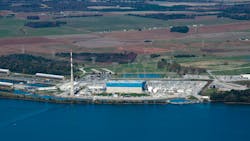Ongoing Developments In Nuclear Power Generation Thicken Plot for Data Centers
The last couple of years have seen a lot of public statements about nuclear-powered data centers, but it’s important to understand the reality of the situations being discussed for short-term use. If we aren’t quite yet discerning dedicated nuclear reactors running individual data centers, the future prospect of data center campuses being colocated with existing nuclear power plants is becoming more palpable.
For instance, last year we reported on how Green Energy Partners (GEP) is planning a data center and energy campus near the Surry Nuclear Power Plant in Virginia, calling for 30 data centers on a nearly 600-acre tract of land, and on-site power from small modular reactors and hydrogen generation.
This month, as reported by the Smithfield Times, Surry County’s Planning Commission unanimously endorsed Middleburg-based GEP's plans to build a first-in-the-nation combination data center and hydrogen fuel hub adjacent to Dominion Energy’s nuclear power plant.
GEP expects to break ground this year on the data centers, which will be the project’s first phase conditioned on it receiving rezoning approval.
As reported by the Smithfield Times' Stephen Faleski:
Days after Surry supervisors approved the creation of a new 'emerging technologies' zoning district, Green Energy submitted a formal application for rezoning and a map amendment to Surry’s comprehensive plan. With the Planning Commission’s 10-0 approval recommendation on Jan. 29, the matter will head to Surry’s supervisors, likely this month, for a final vote.
Other data center projects focused on proximity to existing nuclear facilities have included Cumulus Data, who just over a year ago announced that it had completed the shell for a 48-megawatt (MW) data center with a direct connection to the Susquehanna Steam Electric Station, a nuclear power plant in Northeast Pennsylvania. The facility isn’t one of the more recent nuclear plants in the US, with Unit 1 going online in 1983 and Unit 2 in 1985.
With the plant being capable of generating 2.5 GWh annually (1.257 GWh per unit), Cumulus plans to add two additional 48MW shells in their Phase 1 development, building towards an eventual aggregate development of 475 MW of capacity. This is very aggressive planning and the anchor customer is the zero-carbon bitcoin miner TeraWulf, who voiced plans to ramp up to 50 MW of net mining capacity last year.
As we talked about last week, there are a lot of planned projects and changes coming to the nuclear industry. Given the widely acknowledged constraints on the future of data center power, each one of these projects must now be viewed as a potential locus of data center development.
Michigian Holds Out Holtec's Nuclear Ambitions
While California’s ongoing battle to close down the Diablo Canyon Nuclear Generating Plant and the realization that that couldn’t happen while California still needed that 2.5 GW of power has gotten the lion’s share of the media coverage, Michigan is the site of potentially more important news -- the first reopening of a previously shuttered nuclear power plant.
Back in Q2 2023, Holtec International, a company known for dismantling shuttered nuclear power plants, announced that they were looking to restart one of their more recent acquisitions, the Palisades Nuclear Generating Station.
The nuclear plant was commissioned at the end of 1971 and had been “permanently” shut down in May of 2022, with its operator no longer considering plant operation financially viable.
Holtec purchased the plant in June of 2022 and immediately applied for funds to reopen the facility. Within two months, that request for funding had been denied.
In September of last year, Holtec was able to sign two muilti-decade purchase agreements for power from the 800 MW plant with Wolverine Power Cooperative, a not-for-profit energy provider serving rural communities across Michigan, who agreed to purchase up to two-thirds of the plant’s power output; and Bloomington, Indiana-based cooperative Hoosier Energy, purchasing the rest.
Just getting the contract signed didn’t seem to be enough to get the company funding to restart the plant, and with the support of Michigan’s Governor Gretchen Whitmer, Holtec was able to get $150 million in state funding to keep its efforts to reopen the plant alive.
It's All About the Benjamins
But for an area such as Michigan with a need for additional power, good news was on the horizon. In early February it was announced that the federal government was expected to approve a $1.5 billion loan to restart the Holtec nuclear plant.
Holtec spokesman Nick Culp, on the importance of hitting government goals for clean energy, told Bloomberg News, “Palisades and nuclear power plants like it are essential to achieving those target goals, while also making sure that we have a reliable electricity that all of us depend on.”
While there are few facilities taken offline as recently as Palisades, there are dozens of previously NRC-approved locations for new nuclear facilities that were never further developed due to costs and a lack of perceived need.
Many of those locations are for additional reactors co-located with existing nuclear power plants. The fact that the locations are approved means that a significant part of the pre-construction process for any commercial nuclear facility has already been addressed.
The Tennesee Valley Authority (TVA) is a good example of this, currently operating seven reactors at three locations: Browns Ferry, near Athens, Alabama; Sequoyah, in Soddy-Daisy, Tennessee; and Watts Bar, near Spring City, Tennessee.
TVA had no fewer than three other approved reactor sites, including Phibbs Bend in Tennessee, where they invested $4 billion in infrastructure before abandoning the project. At the time, one of the reasons given for the cessation of new construction was a perceived lack of future need for additional facilities.
Well, that might go down as a monumental error in future planning for power use, especially considering the power outages experienced in 2022-23 in the TVA service area.
More Power Isn’t a Nice-to-Have: It’s a Must
The spate of power outages could be part of the motivation for the TVA’s interest in SMRs, where they are involved in a single-reactor pilot program at their Clinch River site in Oak Ridge, Tennessee to deploy a GE-Hitachi BWRX-300 small modular reactor.
If it works out, the plan is to grow it to a 4-unit site, with long-term plans to replicate the 4-unit cluster at no fewer than four additional TVA sites. The TVA has stated that they plan to submit a construction permit to the NRC by the end of Q2 2024.
TVA President and CEO Jeff Lyash said in an interview that the TVA needed 20 new nuclear units to decarbonize its power generation by 2050, which is why he has been famously quoted as saying he didn’t want the aggravation of building a single traditional reactor when he needed at least twenty -- a requirement that SMR designs seem directly suited for.
Repurposing Other Industrial Sites
The US Department of Energy has announced plans to invest nearly $2 billion in a retiring coal plant in Kemmerer, Wyoming where TerraPower plans to build its sodium-cooled fast reactor and molten salt energy storage system.
TerraPower is one of two teams awarded funding through the Advanced Reactor Demonstration Program, a project to test, license, and build the next generation of American advanced reactors.
TerraPower's Natrium reactor system uses a simplified design and advanced construction methods, which will ideally speed up construction, while lowering costs and delivering another carbon-free energy generation technology. And the use of an existing fossil fuel site makes it that much more of a green solution.
While not nuclear generation projects, there are two other projects in process that will use existing nuclear generation facilities' power generation to enable clean hydrogen energy production.
Supported by the US Department of Energy, the projects are being offered by Energy Harbor at the Davis-Besse Nuclear Power Station in Ohio, and Xcel Energy at the Prairie Island Nuclear Generating Plant in Minnesota.
The two projects, taking different approaches to hydrogen generation through electrolysis will be able to offer fuel for local manufacturing, including data center operators, and transportation industries.
This recent video from The Economist explains how one of the keys to a smooth transition to a green economy will be nuclear power.
About the Author



